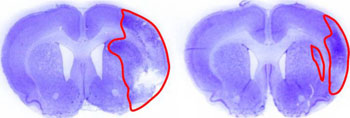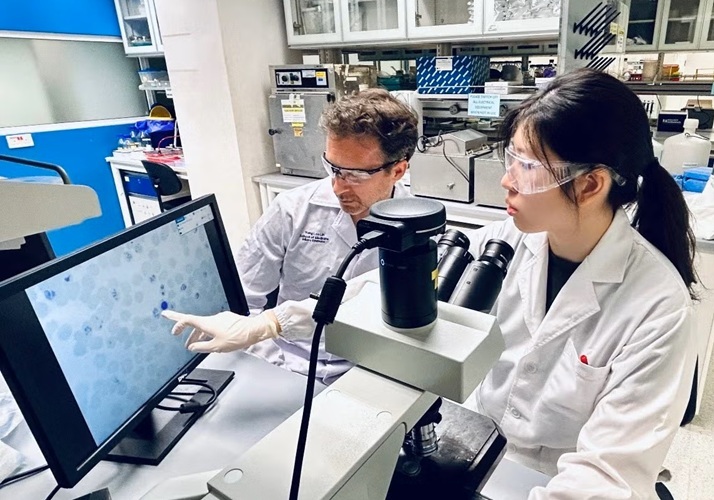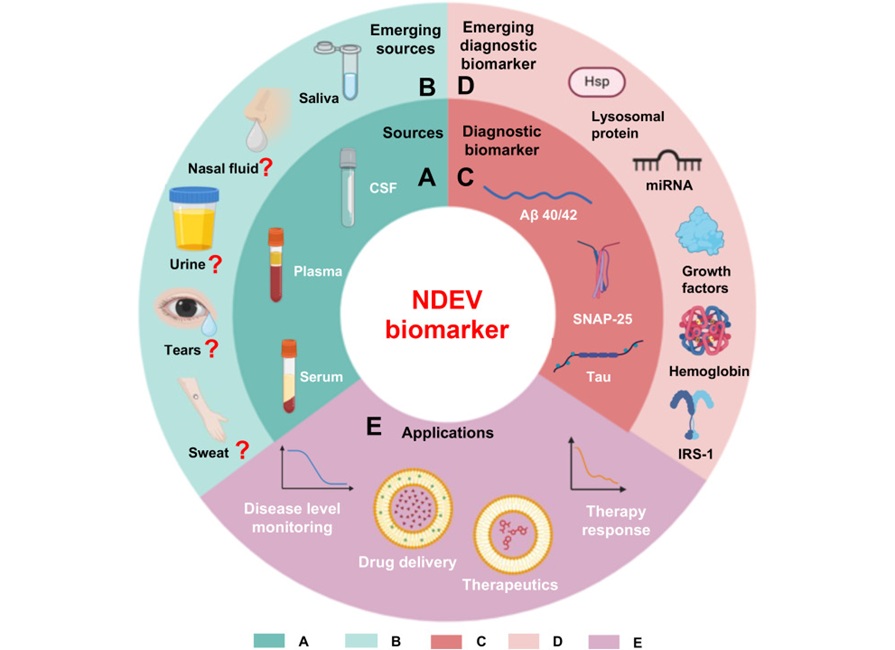Blocking a Long Noncoding RNA Reduces Stroke Damage in Rat Model
|
By LabMedica International staff writers Posted on 29 Dec 2015 |

Image: Brain damage is outlined in red for rats that were treated to block one type of RNA (right), compared to controls (left) (Photo courtesy of Raghu Vemuganti, Suresh Mehta and TaeHee Kim, University of Wisconsin-Madison).
By preventing expression of a long noncoding RNA (lncRNA) following induced stroke in a rat model, neurosciences researchers were able to limit damage to the brain and reduce the severity of post-stroke symptoms.
Long noncoding RNAs (lncRNAs) are non-protein coding transcripts longer than 200 nucleotides. This somewhat arbitrary limit distinguishes lncRNAs from small regulatory RNAs such as microRNAs (miRNAs), short interfering RNAs (siRNAs), Piwi-interacting RNAs (piRNAs), small nucleolar RNAs (snoRNAs), and other short RNAs. LncRNAs have been found to be involved in numerous biological roles including imprinting, epigenetic gene regulation, cell cycle and apoptosis, and metastasis and prognosis in solid tumors. Most lncRNAs are expressed only in a few cells rather than whole tissues, or they are expressed at very low levels, making them difficult to study.
In addition to protein-coding RNAs, many classes of noncoding RNAs, including lncRNAs, undergo changes in the brain following a stroke. To better understand the roll of non-coding RNAs in stroke, investigators at the University of Wisconsin-Madison (USA) evaluated the functional significance of an lncRNA called FosDT (Fos downstream transcript) that is coded on the same chromosome as the FOS gene (FBJ murine osteosarcoma viral oncogene homolog). The FOS proteins have been implicated as regulators of cell proliferation, differentiation, and transformation. In some cases, expression of the FOS gene has also been associated with apoptotic cell death.
In the current study, ischemic stroke was induced in laboratory rats by blocking an artery in the brain for one hour. Some of the animals were treated with anti-sense RNA that blocked the production of the lncRNA FosDT.
Results published in the December 16, 2015, issue of the Journal of Neuroscience revealed that stroke induced production of FOS and FosDT in the untreated animals. In the treated animals FosDT knockdown significantly ameliorated post-ischemic motor deficits and reduced the infarct volume. These effects of FosDT in part were due to its interactions with chromatin-modifying proteins Sin3a and coREST (corepressors of the transcription factor REST) and subsequent derepression of REST-downstream genes GRIA2, NFkappaB2, and GRIN1.
"Stroke influences the expression of all types of RNA, and this RNA has a broad influence throughout the cell after the blood supply is restored, in what we call reperfusion injury," said senior author Dr. Raghu Vemuganti, professor of neurological surgery at the University of Wisconsin-Madison. "A few years ago, our lab started to look at how stroke affects noncoding RNA. Two years ago, we identified about 200 types of various lncRNAs that greatly increase or decrease after stroke, and zeroed in on one that we named FosDT. We knew that the level of FosDT went up more than tenfold in the rat brain within three hours after the stroke. We thought, if we block FosDT after the stroke, would it make any difference in the amount of structural damage or behavioral disability?"
"We did not change the initial insult, caused by lack of oxygen," said Dr. Vemuganti, "but this targeted approach greatly reduced the damage after one week. We cannot completely reverse the post-stroke damage, but the total damage decreased by one-third. If we can protect this much brain tissue from stroke, that would be an enormous improvement."
Related Links:
University of Wisconsin-Madison
Long noncoding RNAs (lncRNAs) are non-protein coding transcripts longer than 200 nucleotides. This somewhat arbitrary limit distinguishes lncRNAs from small regulatory RNAs such as microRNAs (miRNAs), short interfering RNAs (siRNAs), Piwi-interacting RNAs (piRNAs), small nucleolar RNAs (snoRNAs), and other short RNAs. LncRNAs have been found to be involved in numerous biological roles including imprinting, epigenetic gene regulation, cell cycle and apoptosis, and metastasis and prognosis in solid tumors. Most lncRNAs are expressed only in a few cells rather than whole tissues, or they are expressed at very low levels, making them difficult to study.
In addition to protein-coding RNAs, many classes of noncoding RNAs, including lncRNAs, undergo changes in the brain following a stroke. To better understand the roll of non-coding RNAs in stroke, investigators at the University of Wisconsin-Madison (USA) evaluated the functional significance of an lncRNA called FosDT (Fos downstream transcript) that is coded on the same chromosome as the FOS gene (FBJ murine osteosarcoma viral oncogene homolog). The FOS proteins have been implicated as regulators of cell proliferation, differentiation, and transformation. In some cases, expression of the FOS gene has also been associated with apoptotic cell death.
In the current study, ischemic stroke was induced in laboratory rats by blocking an artery in the brain for one hour. Some of the animals were treated with anti-sense RNA that blocked the production of the lncRNA FosDT.
Results published in the December 16, 2015, issue of the Journal of Neuroscience revealed that stroke induced production of FOS and FosDT in the untreated animals. In the treated animals FosDT knockdown significantly ameliorated post-ischemic motor deficits and reduced the infarct volume. These effects of FosDT in part were due to its interactions with chromatin-modifying proteins Sin3a and coREST (corepressors of the transcription factor REST) and subsequent derepression of REST-downstream genes GRIA2, NFkappaB2, and GRIN1.
"Stroke influences the expression of all types of RNA, and this RNA has a broad influence throughout the cell after the blood supply is restored, in what we call reperfusion injury," said senior author Dr. Raghu Vemuganti, professor of neurological surgery at the University of Wisconsin-Madison. "A few years ago, our lab started to look at how stroke affects noncoding RNA. Two years ago, we identified about 200 types of various lncRNAs that greatly increase or decrease after stroke, and zeroed in on one that we named FosDT. We knew that the level of FosDT went up more than tenfold in the rat brain within three hours after the stroke. We thought, if we block FosDT after the stroke, would it make any difference in the amount of structural damage or behavioral disability?"
"We did not change the initial insult, caused by lack of oxygen," said Dr. Vemuganti, "but this targeted approach greatly reduced the damage after one week. We cannot completely reverse the post-stroke damage, but the total damage decreased by one-third. If we can protect this much brain tissue from stroke, that would be an enormous improvement."
Related Links:
University of Wisconsin-Madison
Latest BioResearch News
- Genome Analysis Predicts Likelihood of Neurodisability in Oxygen-Deprived Newborns
- Gene Panel Predicts Disease Progession for Patients with B-cell Lymphoma
- New Method Simplifies Preparation of Tumor Genomic DNA Libraries
- New Tool Developed for Diagnosis of Chronic HBV Infection
- Panel of Genetic Loci Accurately Predicts Risk of Developing Gout
- Disrupted TGFB Signaling Linked to Increased Cancer-Related Bacteria
- Gene Fusion Protein Proposed as Prostate Cancer Biomarker
- NIV Test to Diagnose and Monitor Vascular Complications in Diabetes
- Semen Exosome MicroRNA Proves Biomarker for Prostate Cancer
- Genetic Loci Link Plasma Lipid Levels to CVD Risk
- Newly Identified Gene Network Aids in Early Diagnosis of Autism Spectrum Disorder
- Link Confirmed between Living in Poverty and Developing Diseases
- Genomic Study Identifies Kidney Disease Loci in Type I Diabetes Patients
- Liquid Biopsy More Effective for Analyzing Tumor Drug Resistance Mutations
- New Liquid Biopsy Assay Reveals Host-Pathogen Interactions
- Method Developed for Enriching Trophoblast Population in Samples
Channels
Clinical Chemistry
view channel
Compact Raman Imaging System Detects Subtle Tumor Signals
Accurate cancer diagnosis often depends on labor-intensive tissue staining and expert pathological review, which can delay results and limit access to rapid screening. These conventional methods also make... Read more
Noninvasive Blood-Glucose Monitoring to Replace Finger Pricks for Diabetics
People with diabetes often need to measure their blood glucose multiple times a day, most commonly through finger-prick blood tests or implanted sensors. These methods can be painful, inconvenient, and... Read moreMolecular Diagnostics
view channel
Blood Test Could Identify Biomarker Signature of Cerebral Malaria
Malaria remains a major cause of death and long-term disability in many low- and middle-income countries, with around 600,000 deaths reported globally each year. The most severe form, cerebral malaria,... Read more
World’s First Biomarker Blood Test to Assess MS Progression
Multiple sclerosis (MS) disease activity is caused by an abnormal immune response that results in damage to the brain and spinal cord. However, there is a lack of reliable tools to measure or predict MS progression.... Read moreHematology
view channel
MRD Tests Could Predict Survival in Leukemia Patients
Acute myeloid leukemia is an aggressive blood cancer that disrupts normal blood cell production and often relapses even after intensive treatment. Clinicians currently lack early, reliable markers to predict... Read more
Platelet Activity Blood Test in Middle Age Could Identify Early Alzheimer’s Risk
Early detection of Alzheimer’s disease remains one of the biggest unmet needs in neurology, particularly because the biological changes underlying the disorder begin decades before memory symptoms appear.... Read more
Microvesicles Measurement Could Detect Vascular Injury in Sickle Cell Disease Patients
Assessing disease severity in sickle cell disease (SCD) remains challenging, especially when trying to predict hemolysis, vascular injury, and risk of complications such as vaso-occlusive crises.... Read more
ADLM’s New Coagulation Testing Guidance to Improve Care for Patients on Blood Thinners
Direct oral anticoagulants (DOACs) are one of the most common types of blood thinners. Patients take them to prevent a host of complications that could arise from blood clotting, including stroke, deep... Read moreImmunology
view channel
Ultrasensitive Liquid Biopsy Demonstrates Efficacy in Predicting Immunotherapy Response
Immunotherapy has transformed cancer treatment, but only a small proportion of patients experience lasting benefit, with response rates often remaining between 10% and 20%. Clinicians currently lack reliable... Read more
Blood Test Could Identify Colon Cancer Patients to Benefit from NSAIDs
Colon cancer remains a major cause of cancer-related illness, with many patients facing relapse even after surgery and chemotherapy. Up to 40% of people with stage III disease experience recurrence, highlighting... Read moreMicrobiology
view channel
New UTI Diagnosis Method Delivers Antibiotic Resistance Results 24 Hours Earlier
Urinary tract infections affect around 152 million people every year, making them one of the most common bacterial infections worldwide. In routine medical practice, diagnosis often relies on rapid urine... Read more
Breakthroughs in Microbial Analysis to Enhance Disease Prediction
Microorganisms shape human health, ecosystems, and the planet’s climate, yet identifying them and understanding how they are related remains a major scientific challenge. Even with modern DNA sequencing,... Read morePathology
view channel
Genetics and AI Improve Diagnosis of Aortic Stenosis
Aortic stenosis is a progressive narrowing of the aortic valve that restricts blood flow from the heart and can be fatal if left untreated. There are currently no medical therapies that can prevent or... Read more
AI Tool Simultaneously Identifies Genetic Mutations and Disease Type
Interpreting genetic test results remains a major challenge in modern medicine, particularly for rare and complex diseases. While existing tools can indicate whether a genetic mutation is harmful, they... Read more
Rapid Low-Cost Tests Can Prevent Child Deaths from Contaminated Medicinal Syrups
Medicinal syrups contaminated with toxic chemicals have caused the deaths of hundreds of children worldwide, exposing a critical gap in how these products are tested before reaching patients.... Read more
Tumor Signals in Saliva and Blood Enable Non-Invasive Monitoring of Head and Neck Cancer
Head and neck cancers are among the most aggressive malignancies worldwide, with nearly 900,000 new cases diagnosed each year. Monitoring these cancers for recurrence or relapse typically relies on tissue... Read moreTechnology
view channel
AI Predicts Colorectal Cancer Survival Using Clinical and Molecular Features
Colorectal cancer is one of the most common and deadly cancers worldwide, and accurately predicting patient survival remains a major clinical challenge. Traditional prognostic tools often rely on either... Read more
Diagnostic Chip Monitors Chemotherapy Effectiveness for Brain Cancer
Glioblastoma is one of the most aggressive and fatal brain cancers, with most patients surviving less than two years after diagnosis. Treatment is particularly challenging because the tumor infiltrates... Read moreIndustry
view channel
BD and Penn Institute Collaborate to Advance Immunotherapy through Flow Cytometry
BD (Becton, Dickinson and Company, Franklin Lakes, NJ, USA) has entered into a strategic collaboration with the Institute for Immunology and Immune Health (I3H, Philadelphia, PA, USA) at the University... Read more




 assay.jpg)















